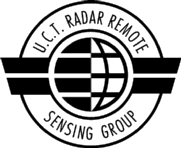 |
The South African VHF Synthetic Aperture Radar System
(SASAR VHF)
|

Main Menu:
Background and System Description
SASAR is the South African Synthetic Aperture Radar which operates in the
VHF frequency band. This medium resolution (12 MHz bandwidth), airborne
system originated at the University of Cape Town Radar
Remote Sensing Group (RRSG) where all signal processing for the system
is performed. CSIR - Defencetek is
responsible for the system integration and manages the project. Funding
for the project has been provided by Armscor.
Although originally designed to be installed on a Boeing 707 aircraft,
the experimental radar is currently installed in a South African Airforce
DC3 (Dakota) aircraft.
Several photos are available of the system:
The VHF frequency of operation has certain unique characteristics which
differ from higher frequency SAR systems:
-
Good foliage canopy penetration. This allows for possible applications
of "bald earth" topography mapping and the detection of vehicles under
bush cover.
-
Good ground penetration capabilities are expected in arid regions. The
use of the radar for geological- and hydrological mapping applications
is under investigation.
-
The radar is very sensitive to large scale man-made structures such as
buildings, fences, power lines. Investigation is also being made into ship
detection for maritime patrol applications.
-
As the radar is sensitive to objects of a different (larger) scale than
with higher frequency systems, a comparison of the imagery from a VHF radar
and a higher frequency radar provides additional information.
Operation in the VHF frequency band presents some specific problems:
-
The band over which the radar operates is heavily contaminated with interference
from radio communications. Interference suppression algorithms have been
developed at RRSG to combat this problem and these now form a standard
part of the signal processor.
-
Longer synthetic apertures are required at VHF frequencies than at higher
frequencies to achieve a given azimuth resolution for a given target closest
approach range. This, in turn, has implications on the motion compensation
requirements of the system. Biases and drifts in the on-board accelerometers
result in unacceptable position errors, leading to loss of image focus.
To combat this, a differential GPS system is used in conjunction with the
inertial measurement unit. Using this approach accuracy has been sufficient
for repeat pass interferomerty.
System Upgrades and Activities
Two important recent upgrades have been made to the system, improving the
image quality:
-
The incorporation of a pulse expander. As the system was originally intended
for installation on a Boeing 707 aircraft, a larger array structure was
planned than is currently in use on the DC3. This and other adaptions (such
as in the beam former) has reduced the system SNR over that originally
intended. The pulse expander allows the use of longer transmit pulses,
improving the SNR in the focused images while maintaining range resolution.
Although any pulse modulation is possible, a linear FM chirp pulse is typically
used with the system.
-
The incorporation of a differential GPS (DGPS) system to assist in motion
compensation. An OmniSTAR DGPS system
is used in conjunction with an inertial measurement unit (IMU). The use
of the OmniSTAR system removes the requirement for the user to have to
set up DGPS ground stations. The DGPS assists in removing the drifts and
biases of the IMU data, important over the long VHF synthetic apertures.
Other work planned:
-
Work on fuller system characterisation.
-
Tests in a number of application areas.
Links to Related Sites
-
A SAR system operating at even lower frequencies than SASAR is the CARABAS
II system from Sweden. This radar operates from 20 - 90 MHz, using
a stepped frequency technique.
Enquiries / suggestions
about this site or the SASAR system or signal processing.
Up to RRSG home page
This page last updated by tb
2005-07-07 (C) UCT 1999-2000


